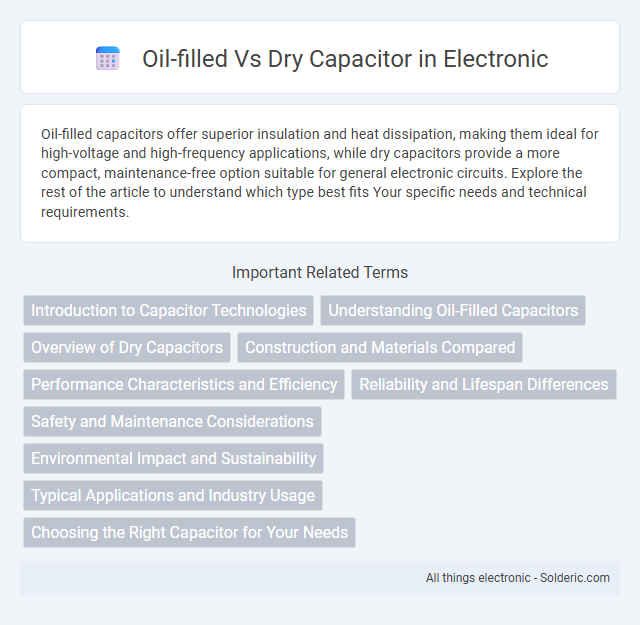Oil-filled capacitors offer superior insulation and heat dissipation, making them ideal for high-voltage and high-frequency applications, while dry capacitors provide a more compact, maintenance-free option suitable for general electronic circuits. Explore the rest of the article to understand which type best fits Your specific needs and technical requirements.
Comparison Table
| Feature | Oil-Filled Capacitor | Dry Capacitor |
|---|---|---|
| Dielectric Medium | Mineral oil | Solid dielectric (e.g., polyester, polypropylene) |
| Insulation | Oil provides high insulation and cooling | Solid insulation, less cooling capability |
| Voltage Rating | High voltage applications (up to several kV) | Medium to high voltage (usually lower than oil-filled) |
| Size | Generally larger due to oil tanks | Compact and lightweight |
| Maintenance | Requires regular checks for oil leaks and quality | Low maintenance |
| Environmental Impact | Oil leakage can cause contamination | Environmentally safer, no oil involved |
| Cost | Higher initial and maintenance costs | Generally cheaper and cost-effective |
| Applications | Power factor correction, high voltage filtering | Electronics, motor run capacitors, low-voltage applications |
Introduction to Capacitor Technologies
Oil-filled capacitors provide superior insulation and cooling through oil immersion, enhancing their reliability and performance in high-voltage and industrial applications. Dry capacitors use solid or polymer dielectrics, offering lightweight design and environmental advantages without the risk of oil leakage. The choice between oil-filled and dry capacitors depends on factors such as voltage rating, operating environment, and maintenance requirements.
Understanding Oil-Filled Capacitors
Oil-filled capacitors contain a dielectric immersed in insulating oil, which enhances heat dissipation and electrical insulation, making them ideal for high-voltage and high-frequency applications. Their robust construction provides superior reliability and longer lifespan compared to dry capacitors, which use solid or gaseous dielectrics and may be more prone to moisture ingress and thermal degradation. Oil-filled capacitors are commonly used in power factor correction, motor start circuits, and industrial equipment where stable capacitance and durability under harsh conditions are critical.
Overview of Dry Capacitors
Dry capacitors feature solid or powdered dielectric materials, offering enhanced safety and lower environmental impact compared to oil-filled capacitors. Their maintenance-free design and resistance to leakage make dry capacitors ideal for applications requiring reliability and ease of installation. You can expect dry capacitors to deliver consistent performance in industrial motors, lighting systems, and power correction without the hazards associated with oil.
Construction and Materials Compared
Oil-filled capacitors use mineral oil or synthetic fluid to enhance dielectric strength and cooling, housed in a sealed metal or plastic enclosure, which improves reliability and longevity under high voltage conditions. Dry capacitors consist of a solid or polymer dielectric material such as polypropylene or ceramic, offering compact size, lower leakage current, and better environmental safety since they avoid liquid dielectric risks. Your choice depends on application demands, where oil-filled capacitors excel in high-voltage, high-capacity scenarios, while dry capacitors suit where low maintenance and compact dimensions are preferred.
Performance Characteristics and Efficiency
Oil-filled capacitors exhibit superior performance characteristics with higher dielectric strength and better thermal stability, resulting in enhanced efficiency under high voltage and temperature conditions. Dry capacitors offer lower loss and faster response times, making them more efficient for applications requiring quick energy discharge and improved reliability in variable environments. The choice between oil-filled and dry capacitors depends on the specific operational demands, such as power factor correction or pulse applications, where dielectric properties and efficiency directly impact performance.
Reliability and Lifespan Differences
Oil-filled capacitors offer superior reliability and longer lifespan due to their ability to dissipate heat effectively and resist environmental factors, reducing the risk of dielectric breakdown. Dry capacitors, while more compact and environmentally friendly, generally have shorter operational life and are more susceptible to moisture and temperature variations. Your choice should consider these performance differences based on the intended application and operating conditions.
Safety and Maintenance Considerations
Oil-filled capacitors offer superior electrical insulation and heat dissipation,but pose higher risks of leakage and fire hazards due to their flammable dielectric fluid. Dry capacitors use solid or polymer dielectrics, significantly reducing fire risk and requiring less maintenance, making them safer for environments with strict safety standards. You should consider the operating environment and maintenance capabilities when choosing between oil-filled and dry capacitors for reliable and secure performance.
Environmental Impact and Sustainability
Oil-filled capacitors often contain mineral oils that pose environmental risks due to potential leaks and difficult disposal processes, impacting soil and water quality. Dry capacitors provide a more sustainable alternative with their non-toxic materials and easier recyclability, significantly reducing environmental hazards. Your choice influences ecological footprint, favoring dry capacitors for greener, safer applications.
Typical Applications and Industry Usage
Oil-filled capacitors are commonly used in high-voltage power transmission, industrial motor drives, and power factor correction due to their superior insulation and thermal stability. Dry capacitors find typical applications in consumer electronics, low-voltage circuits, and RF devices because of their compact size and environmental safety. Industries such as power utilities and heavy manufacturing favor oil-filled capacitors, while electronics manufacturers and telecommunications sectors predominantly use dry capacitors.
Choosing the Right Capacitor for Your Needs
When choosing the right capacitor for your needs, consider the advantages of oil-filled capacitors, which offer better insulation properties and higher voltage ratings, making them ideal for high-power applications. Dry capacitors are more compact, maintenance-free, and environmentally friendly, suitable for everyday electronics and lower voltage circuits. Your decision should align with the specific requirements of your project, including voltage levels, environmental conditions, and reliability demands.
Oil-filled vs dry capacitor Infographic

 solderic.com
solderic.com